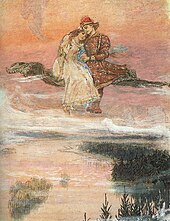Magic carpet
| Magic carpet | |
|---|---|
| Middle Eastern literatureelement | |
 Riding a Flying Carpet,an 1880 painting byViktor Vasnetsov | |
| Genre | Fantasy |
| In-universe information | |
| Type | Magicalcarpet |
| Function | Transportation |
| Traits and abilities | Capable of flight, or instant replacement |
Amagic carpet,also called aflying carpet,is a legendarycarpetand common trope infantasyfiction.It is typically used as a form of transportation and can quickly or instantaneously carry its user(s) to their destination.
In literature
[edit]One of the storiesin theOne Thousand and One Nightsrelates how Prince Husain, the eldest son ofSultan of the Indies,travels to Bisnagar (Vijayanagara) in India and buys a magic carpet.[1]This carpet is described as follows: "Whoever sitteth on this carpet and willeth in thought to be taken up and set down upon other site will, in the twinkling of an eye, be borne thither, be that place nearhand or distant many a day's journey and difficult to reach."[2]The literary traditions of several other cultures also feature magical carpets, in most cases literally flying rather than instantly transporting their passengers from place to place.

Solomon's carpet[3]was reportedly made of green silk with a golden weft, sixty miles (97 km) long and sixty miles (97 km) wide: "when Solomon sat upon the carpet he was caught up by the wind, and sailed through the air so quickly that he breakfasted atDamascusand supped inMedia."[4]Thewindfollowed Solomon's commands, and ensured the carpet would go to the proper destination; when Solomon was proud, for his greatness and many accomplishments, the carpet gave a shake and 40,000 fell to their deaths.[5]The carpet was shielded from the sun by a canopy of birds. In Shaikh Muhammad ibn Yahya al-Tadifi al-Hanbali's book of wonders,Qala'id-al-Jawahir( "Necklaces of Gems" ), ShaikhAbdul-Qadir Gilaniwalks on the water of theRiver Tigris,then an enormous prayer rug (sajjada) appears in the sky above, "as if it were the flying carpet of Solomon [bisat Sulaiman] ".[6]
In Russian folk tales,Baba Yagacan supplyIvan the Foolwith a flying carpet or some other magical gifts (e.g. a ball that rolls in front of the hero showing him the way, or a towel that can turn into a bridge). Such gifts help the hero to find his way "beyond thrice-nine lands, in the thrice-ten kingdom". Russian painterViktor Vasnetsovillustrated the tales featuring a flying carpet on two occasions.
InMark Twain's "Captain Stormfield's Visit to Heaven",magic wishing carpets are used to instantaneously travel throughout Heaven.
Poul Anderson'sOperation Chaosfeatures a world making extensive use ofmagicin daily life, and among other things having flying carpets as a common, non-polluting means of transportation - in fierce competition with the also availableflying brooms.Travelers need not sit on the bare carpet itself, as the carpet serves as the platform for a comfortable cabin.
Magic carpets have also been featured in modern literature, movies, and video games, and not always in a classic context.
In "traditional Chinesefantasy literature"from the lateQing dynastyand before,sentientflying carpets were thought to be "magicalmonsters"in the same category aslung,qilin,orcloudsfor heroes to traverse distances with.[7]
InTaoismand Taoist art, flying carpets were used as poetic metaphors for the ability of flightxianhad.[8]
InTibetanTantric Buddhism,a paper carpet were thought to be able to fly for "adept[s]".[9]

See also
[edit]- The Phoenix and the Carpet– 1904 children's novel byE. Nesbit
- Old Khottabych– 1938 Soviet children's book and later 1956 film with the depiction of a flying carpet
- "Magic Carpet Ride"– 1968 song bySteppenwolf
- Asterix and the Magic Carpet– 1987 illustrated comic story book on the adventures ofAsterix,ObelixandCacofonixinIndia
- King Solomon's Carpet– 1991 novel byBarbara Vineabout theLondon Underground
- Magic Carpet– 1994 video game featuring flight and combat in a realm of magic and monsters
Notes
[edit]- ^Brewers Dictionary of Phrase and Fable, p. 3051894.
- ^Burton, RichardThe Thousand Nights and a NightVol. 13, 1885
- ^Retold for children by Sulamith Ish-Kishor,The carpet of Solomon: A Hebrew legend1966.
- ^The Jewish Encyclopedia,s.v.Solomon: Solomon's carpet "
- ^The Jewish Encyclopedia,ibid.
- ^Qala'id-al-Jawahirbook 6
- ^Jiang, Qian (2013). "Translation and the Development of Science Fiction in Twentieth-Century China".Science Fiction Studies.40(1): 124.doi:10.5621/sciefictstud.40.1.0116.ISSN0091-7729.JSTOR10.5621/sciefictstud.40.1.0116.
- ^Carlson, Kathie; Flanagin, Michael N.; Martin, Kathleen; Martin, Mary E.; Mendelsohn, John; Rodgers, Priscilla Young; Ronnberg, Ami; Salman, Sherry; Wesley, Deborah A. (2010). Arm, Karen; Ueda, Kako; Thulin, Anne; Langerak, Allison; Kiley, Timothy Gus; Wolff, Mary (eds.).The Book of Symbols: Reflections on Archetypal Images.Köln:Taschen.p. 595.ISBN978-3-8365-1448-4.
- ^Carlson, Kathie; Flanagin, Michael N.; Martin, Kathleen; Martin, Mary E.; Mendelsohn, John; Rodgers, Priscilla Young; Ronnberg, Ami; Salman, Sherry; Wesley, Deborah A. (2010). Arm, Karen; Ueda, Kako; Thulin, Anne; Langerak, Allison; Kiley, Timothy Gus; Wolff, Mary (eds.).The Book of Symbols: Reflections on Archetypal Images.Köln:Taschen.p. 594.ISBN978-3-8365-1448-4.
External links
[edit]- The secret history of the Flying CarpetArchived2005-11-21 at theWayback Machine
